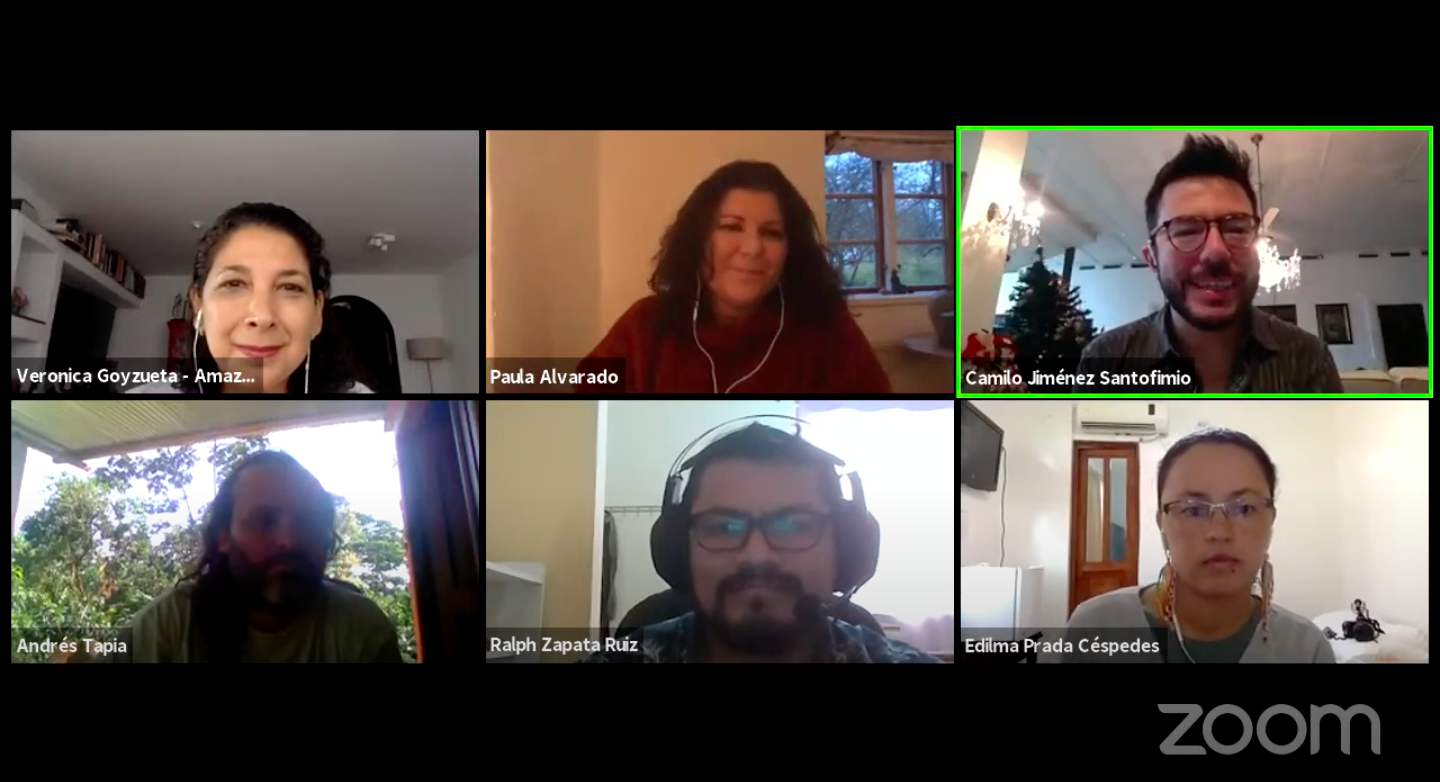Journalist Resource December 11, 2020
Balancing the Narrative in Coverage of the Amazon

How can you promote the exchange of ideas between indigenous people and journalists, in search of a more balanced narrative news coverage of the Amazon forest? This was the central idea of the "Connecting Indigenous and Local Storytellers to Journalism: Experiences and Opportunities" webinar held on Nov. 26, organized by the Amazon Rainforest Journalism Fund and The Tenure Facility.
The title of the event already hinted at its complexities, which the panelists would go on to discuss. Moderator Camilo Jimenez, member of the Amazon RJF advisory committee, pointed out the distinct natures of indigenous storytelling and journalism; the task for news organizations is to find the commonalities between the two forms of communication.
"Sometimes we don't see that journalism is already present in local indigenous narratives and sometimes in journalism there are significant problems that prevent us from having the ability to really listen to or enter local communities," Jimenez explained in his initial question to the panelists.
Edilma Prada, founder and director of Agenda Propia in Colombia, pointed out the need for self-criticism in journalism and the need to respond to a historical call from the indigenous communities to be seen and narrated in a way that respects the traditions of the profession, by understanding their scenarios and telling deeply-reported stories.
"Journalism in general has narrated indigenous peoples from a 'poverty-porn' perspective, or has always narrated them from the point of view of tragedy or emergency, but not from the point of view of diversity, respect, or listening," commented the Colombian journalist.
"In Agenda Propia we have learned that to tell indigenous stories it is necessary to present historical, cosmogonic, social, conflict contacts. The struggles of indigenous peoples are historical, date back many years and are not connected to any one specific event. The stories that journalists cover are usually about a particular fact and don't have room to explain a deeper context," explains Prada, who believes it is necessary to look into new narratives, longer texts and formats that allow covering these stories, in a way that encourages dialogue and promotes new dynamics.
The investigative journalism portal Ojo Público, in Peru, has been seeking this path, including indigenous correspondents in its reporting team. Of its ten correspondents, two are indigenous — one Aguajuna and the other Quechua — and understand those regional world-views well. "That feeling of growing on earth is very different and sometimes it is not understood," says Ralph Zapata Ruiz, regional editor of Ojo Público.
The publication has created a dedicated space to receive contributions from indigenous journalists. "We value the connection between local narrators and their synchronicity with journalists. It's a very enriching process," he says. "It's a constant learning on both sides. We carry methodological processes and they bring their worldview and their cultural background".
Agenda Propia counts with an intercultural team formed by indigenous journalists that participates in the majority of their projects, and that write stories with their own narratives. "There is an imagined idea that indigenous people don't know about things, that they are not capable, and that is how we have often depicted them in the media. But there are indigenous photographers, documentarians and journalists who have been in media spaces like radio for many years," Edilma explained.
The Colombian news portal also established seven steps in its field-based reporting expeditions, among them — a dialogue, the establishment of history with the community, and the inclusion of a diversity of voices with different historical contexts, from women to children and sages. Edilma Prada highlighted the diversity of these narratives, recalling that in Colombia alone there are 115 indigenous peoples, all of them different.
A narrative force of resistance
Andrés Tapia, leader and communications director for the Confederation of Indigenous Nationalities of Ecuador (CONFENIAE), drew attention to the social, spiritual and ancestral issues of indigenous narratives, increasingly valued by specialized journalists, who recognize them as the very narrative of these peoples.
"There is a social and very spiritual view expressed in the mythical stories that grandparents pass on. It carries with it a lot of pain, a lot of suffering that has already been experienced, but it also carries hope, yearnings, all that vision of change that emerges from the territories, and that indigenous narrators offer for journalism, from their own vision, a vision that is very local and concentrated in the Amazon, but which is also a very important contribution to journalism," explains Tapia.
The Ecuadorian journalist highlighted the importance of dreams, individual and collective, from which many narratives are born. "And we must also recognize spaces such as drinking the guayusa. Collective, energetic, epic spaces that are shared at dawn," says Tapia, who considers this oneiric narrative "very powerful."
At the same time, he says, the indigenous narrative opens space for everything that surrounds him in nature, from where positions of struggle against extractivism emerge. "It is a narrative force of resistance," he says.
Paula Alvarado, of The Tenure Facility, said that a difficult point to understand among people in cities is the vision of communities with nature, as their guardians. "The way of good living is integration with nature. Something journalism sometimes approaches as an exotic thing," he explains.
"We have to take these layers of the western vision, enter with respect and also with the humility to understand that we know nothing, that we don't understand the dynamics, and that we need to hear from them how they want to work with us", proposes Alvarado. The Tenure Facility is an international organization that supports indigenous communities working on land rights issues.
In consensus, participants highlighted the importance of listening to the peoples and integrating their narratives in the space of journalism, as well as the importance of integrating the media with indigenous communicators and journalists to welcome the feeling of the peoples.
